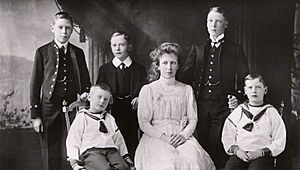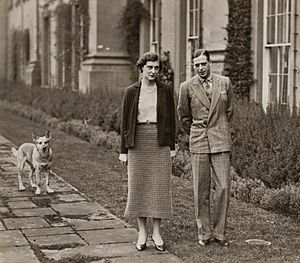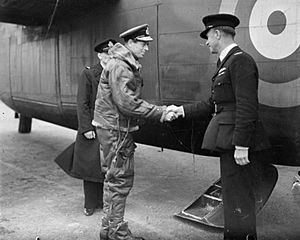Prince George, Duke of Kent facts for kids
Quick facts for kids Prince George |
|||||
|---|---|---|---|---|---|
| Duke of Kent | |||||
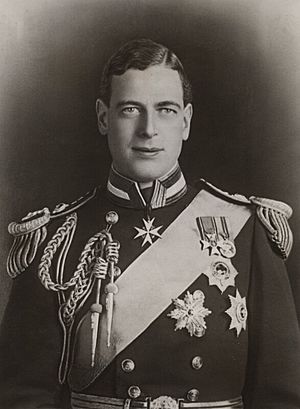
Prince George in 1934
|
|||||
| Born | Prince George of Wales 20 December 1902 York Cottage, Sandringham, Norfolk, England |
||||
| Died | 25 August 1942 (aged 39) Morven, Caithness, Scotland |
||||
| Cause of death | Dunbeath air crash | ||||
| Burial | 29 August 1942 Royal Vault, St George's Chapel, Windsor Castle 29 August 1968 Royal Burial Ground, Frogmore |
||||
| Spouse | |||||
| Issue | |||||
|
|||||
| House |
|
||||
| Father | George V | ||||
| Mother | Mary of Teck | ||||
| Signature |  |
||||
| Education |
|
||||
| Military career | |||||
| Allegiance | |||||
| Service/ |
|||||
| Years of active service | 1916–1942 | ||||
| Rank |
|
||||
| Battles/wars | |||||
Prince George, Duke of Kent (born George Edward Alexander Edmund; 20 December 1902 – 25 August 1942), was a member of the British royal family. He was the fourth son of King George V and Queen Mary. He was also a younger brother to kings Edward VIII and George VI.
Prince George served in the Royal Navy during the 1920s. After that, he worked briefly as a civil servant. In 1934, he became the Duke of Kent. In the late 1930s, he served as an officer in the RAF. He started as a staff officer at RAF Training Command. From July 1941, he worked in the Welfare Section of the RAF Inspector General's Staff. Sadly, he died in a military air crash on 25 August 1942.
Contents
Early Life of Prince George
Prince George was born on 20 December 1902. His birthplace was York Cottage on the Sandringham Estate in Norfolk, England. His father was the Prince of Wales, who later became King George V. King George V was the only surviving son of King Edward VII and Queen Alexandra.
His mother was the Princess of Wales, who later became Queen Mary. She was the only daughter of the Duke and Duchess of Teck. When George was born, he was fifth in line to the throne. This was after his father and his three older brothers: Edward, Albert, and Henry.
George was baptised at Windsor Castle on 26 January 1903. His godparents included his paternal grandparents, King Edward VII and Queen Alexandra. Other godparents were Prince Valdemar of Denmark, Prince Louis of Battenberg, Empress Dowager Maria Feodorovna, and Princess Christian of Schleswig-Holstein.
Education and Royal Career
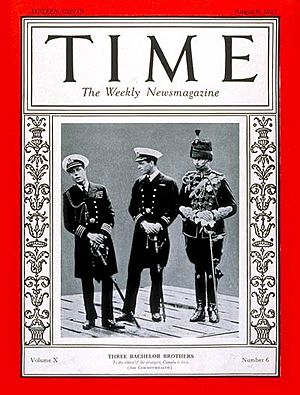
Prince George first had a tutor for his education. Then, he went to St Peter's Court, a school in Broadstairs, Kent. At 13, he joined naval college, just like his older brothers. He studied at Osborne and then at Dartmouth.
He became a sub-lieutenant in the Royal Navy on 15 February 1924. He was promoted to lieutenant on 15 February 1926. He served actively in the Royal Navy until March 1929. He was on ships like HMS Iron Duke and HMS Nelson. Later, he served on HMS Durban in the Americas.
After leaving the navy, he worked briefly at the Foreign Office and then the Home Office. This made him the first royal family member to work as a civil servant. He continued to receive promotions in the navy. He became a commander on 15 February 1934 and a captain on 1 January 1937.
From January to April 1931, Prince George and his older brother, the Prince of Wales, toured South America. They traveled 18,000 miles. They opened a British Empire Exhibition in Buenos Aires. They returned to Europe by ship and then flew from Paris to Windsor Great Park.
On 23 June 1936, George became a personal aide to his eldest brother, King Edward VIII. After Edward VIII gave up the throne, George became a personal naval aide to his elder brother, King George VI. On 12 March 1937, he was made a colonel in the British Army. He also became a group captain in the Royal Air Force (RAF).
In October 1938, George was chosen to be the Governor-General of Australia. This role was supposed to start in November 1939. However, on 11 September 1939, the start of the Second World War caused this appointment to be postponed.
On 8 June 1939, George was promoted to rear admiral in the Royal Navy. He also became a major-general in the British Army and an air vice-marshal in the Royal Air Force. When World War II began, George returned to active naval service. He served briefly in the Intelligence Division of the Admiralty.
Prince George's Family Life
Marriage and Children
On 9 October 1934, Prince George was given new titles. He became Duke of Kent, Earl of St Andrews, and Baron Downpatrick. This was in preparation for his marriage to his second cousin, Princess Marina of Greece and Denmark.
The couple married on 29 November 1934 at Westminster Abbey. After this, they had a Greek ceremony in a private chapel at Buckingham Palace. This chapel was specially changed into an Orthodox chapel for the event. They had three children:
- Prince Edward, Duke of Kent (born 9 October 1935). He married Katharine Worsley on 8 June 1961. They have three children.
- Princess Alexandra, The Hon. Lady Ogilvy (born 25 December 1936). She married the Hon. Angus Ogilvy on 24 April 1963. They had two children.
- Prince Michael of Kent (born 4 July 1942). He married Baroness Marie Christine von Reibnitz on 30 June 1978. They have two children.
Prince George's RAF Career
As a young man, the Duke believed that aviation was the future. Flying became his great passion. In 1929, the Duke earned his pilot's licence. He was the first member of the royal family to fly across the Atlantic Ocean. Before he started flying, he was in the Royal Navy. He trained in intelligence work while stationed at Rosyth.
In March 1937, he was given a commission in the Royal Air Force as a group captain. He was also made the Honorary Air Commodore of No. 500 (County of Kent) Squadron Auxiliary Air Force in August 1938. He was promoted to air vice-marshal in June 1939.
In 1939, he returned to active service as a rear admiral in the Royal Navy. However, in April 1940, he transferred to the Royal Air Force. He temporarily gave up his air officer rank. He became a staff officer at RAF Training Command as a group captain. This was so he would not outrank more experienced officers. On 28 July 1941, he became an air commodore in the Welfare Section of the RAF Inspector General's Staff. In this role, he visited RAF bases to help boost morale during wartime.
The Death of Prince George
On 25 August 1942, Prince George and 14 other people took off in an RAF Short Sunderland flying boat (W4026). They were flying from Invergordon, Ross and Cromarty, to Iceland for non-military duties. The aircraft crashed on Eagle's Rock, a hillside near Dunbeath, Caithness, Scotland. Prince George and all but one of the people on board were killed. He was 39 years old.
His death in RAF service was the first time in over 450 years that a member of the royal family died while on active duty. Prince George's body was first taken to St George's Chapel, Windsor. He was then buried in the Royal Burial Ground, Frogmore, behind Queen Victoria's mausoleum. His elder son, six-year-old Prince Edward, became the new Duke of Kent. His wife, Princess Marina, had given birth to their third child, Prince Michael, only seven weeks before Prince George's death.
One RAF crew member survived the crash: Flight Sergeant Andrew Jack, the Sunderland's rear gunner.
Images for kids
-
Prince George's coat of arms
See also
 In Spanish: Jorge de Kent para niños
In Spanish: Jorge de Kent para niños


